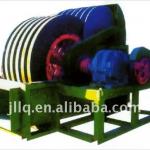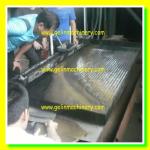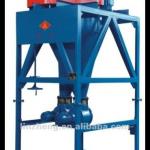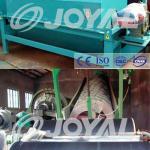hydrocyclone
| Condition:New | Type:Flotation Separator | Place of Origin:Jiangxi China (Mainland) | Brand Name:Naipu |
| Model Number:75-838 |

Hydrocyclone
Usage:
A hydrocyclone is a device that separates mixture of uneven fluids, and it is a device that achieves the separation of two or multiple phases based on the density differential of two or multiple phases with the function of centrifugal force. Due to it that the strength of the centrifugal field is higher than that of the gravitational field, the separation efficiency of the hydrocyclone is higher than that of a gravity classifying device. Therefore, spiral classifiers applied frequently in the past have been replaced by hydrocyclones.
Structure of a hydrocyclone:
The casing and inner rubber liner of a hydrocyclone are two separate units so as to facilitate the replacement of worn parts, in this way it lowers the production costs for the customer compared with using an integrated structure of both the casing and the inner liner as one unit. Besides, an automatic gate valve conveniently operated is installed at the in-let of the cyclone so as to facilitate the operation at a faulty situation.
Research and Development of Equipment:
Due to the high flowing velocity of the fluid inside a hydrocyclone, the inner wall of the casing tend to be worn away more quickly. Considering this issue, we have researched and developed a new composition that suits the inner liner of a hydrocyclone – highly wear-resistant rubber, which significantly extents the service life of the hydrocyclone. In order to meet the different demands for use by our customers, the following cyclone clusters with seven different specifications are our main products:
| Specification (mm) | Φ600 | Φ500 | Φ380 | Φ350 | Φ250 | Φ125 | Φ75 |
| Quantity of cyclones in each cluster (piece) | 4-6 | 4-6 | 4-6 | 4-8 | 4-8 | 4-12 | 4-12 |
The physical characteristics are as the following:
| Color | Red (LINATEX rubber) | Black (NAIPU rubber) |
| Type of polymer | Native rubber | Native rubber |
| hardness | 38 | 40 |
| Tensile strength | 26.6Mpa | 27MPa |
| Extensibility (breaking)% | 810% | ≥800% |
| Permanent deformation | 7 | 8 |
| Tearing strength | 44N/mm | 44N/mm |
| Resilience | 83% | 80% |
| S. G. | 0.97 | 1.15 |
| Temperature range | -40 deg C~ +70 deg C | -20 deg C ~ +75 deg C |
Technical performance and specifications are tabulated as follows:
| Specification (mm) | Φ600 | Φ500 | Φ380 | Φ350 | Φ250 | Φ125 | Φ75 |
| Cylinder ID (mm) | 660 | 500 | 380 | 350 | 250 | 150 | 75 |
| Cylinder height (mm) | 600 | 450 | 330 | 310 | 250 | 210 | 100 |
| Cone angle α(°) | 20 | 20 | 20 | 20 | 20 | 10.20 | 10 |
| Capacity V m3/h (at P0=0.1Mpa ) | 157-580 | 69-480 | 51-200 | 30-168 | 16-110 | 9-51 | 1.8-6.9 |
| Maximum particle size μm in O/F (at δ=2.7t/ m3) | 60-250 | 50-200 | 45-160 | 40-150 | 30-100 | 20-50 | 10-20 |
| Feed line square inlet (mm) | 340x340 | 280x280 | 200x200 | 180x180 | 130x130 | 100x100 | 50x50 |
| Feed line diameter (mm) | Φ150 | Φ130 | Φ96 | Φ90 | Φ65 | Φ32-Φ40 | Φ17 |
| Apex ID (mm) | Φ64 -Φ180 | Φ48-Φ150 | Φ36-Φ100 | Φ34-Φ95 | Φ24 –Φ75 | Φ12 -Φ34 | Φ8 –Φ17 |
| Vortex finder ID (mm) | Φ250 | Φ160 | Φ125 | Φ112 | Φ82 | Φ40 –Φ50 | Φ22 |

| Packaging Detail:standard I/E package |
| Delivery Detail:30 days |














